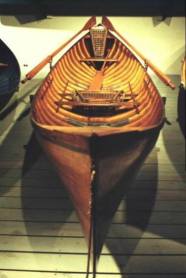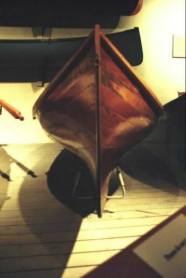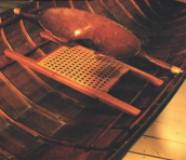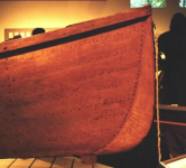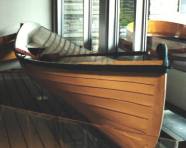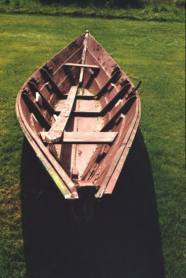-
Years ago, I dismissed the Adirondack guideboat as being little more
than a canoe that was rowed. As I learned more about boat design, I realized
I was wrong.
Here are a few photos
I took at the Adirondack Museum in Blue Mountain Lake, New York. These museum examples allow us to closely
examine the details of these finely crafted
boats. Aside from the fact that I'd rather
see these boats in the water beneath me,
this valuable collection affords the amateur
boatbuilder many ideas that can be
adapted to the construction of small watercraft
using modern materials and techniques.
The construction of one of these boats using
the materials shown in the museum examples
would take take many hours. Builders who still
manufacture these boats are currently charging
between $7,000.00 and $10,000 dollars per boat.
To acquire the materials alone is laborious since
each rib must be gotten out of the butt of a
tamarack tree where the grain of the tree follows
the curve of the rib.
Though no doubt a sacriledge to the the purists
still making boats this way, modern techniques
such as epoxy/strip composite construction are an
obvious choice for the amateur builder.
Glued lapstrake plywood is also a possibility.
Both methods offer the advantages of easier
maintenance and greater strength than the
original method. Most would agree that there
is an aesthetic tradeoff that must pay for
the labor savings gained by not having to
shape each rib.
In fact the ribs can be done away with completely
and the boat built over a jig or form.
As with all boats, these guideboats have several
disadvantages when weighed against other craft
of similar intended use such as canoes and kayaks.
The obvious one is that the oarsman
faces aft. Comical scenes involving an
unsuspecting enthusiast about to go over a
waterfall may come to mind.
Structurally, the big flaw
I see in these boats is the weakness in
the sheer. The outer sheer gunwale is light
and the boats get their stiffness in this area
from the strength of the ribs. As a weight
saving effort, traditional builders eliminated
sheer stiffening thwarts and kept fore and aft
decks and breasthooks minimally small.
The epoxy/strip builder, since he is eliminating
the ribs all together, would no doubt want
to laminate a heavier outwale and add an
inwale as well to stiffen the hull at this
most vulnerable area. The exchange of rib for
inwale, as far as weight is concerned, seems a
reasonable adaptation when converting from
the old method. Some modern builders have opted
for a combination of methods by eliminating
every other rib and covering only the outside
in fiberglass cloth and epoxy resin.
In the examples I have seen, the insides are not
coated with glass but are epoxy coated and then
after laboriously sanding all of those nooks and
crannies, are either varnished or painted.
Though these boats are strong, they are also
heavier. I doubt if there is any labor to be saved in
their construction but certainly an advantage in ease
of maintenance is gained compared to the traditional
method.
Other builders have gone to kevlar as the hull material
of choice. I've never worked with this material but
it probably is the ideal material from a weight and durability
standpoint. Aesthetically, the material leaves much to be desired
and I hear that to do a decent job, the hull must be layed
up in a female mold. This usually excludes this material for the
amateur builder because of the labor and cost involved
to produce the mold to make just one boat.
I am currently working on a ribless cedar strip/epoxy glass version
of a guideboat. Go to my
Current Projects page for more details.
Others have already done the same thing. Go to
my related links page to find other web pages
dealing with this and a variety of other boat
building and design subjects.
GUIDEBOATS FRIENDSHIP SLOOP CURRENT PROJECTS
SIGN GUESTBOOK VIEW GUESTBOOK


